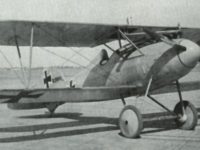At the beginning of 1917, the Germans on the western front earned a few months to seek air superiority for themselves. After the Allied case that the Luftwaffe the Albatros D.V. which, however, fell short of the pilots' expectations.
Development and construction:
With the Sopwith Camel, the S.E.5 and the SPAD S.XIII, the Allies were able to deploy aircraft on the western front in the middle of 1917, which were equal to, if not superior to, the German Albatros D.III. In order to relocate the balance of power in favor of the Germans, the military leadership demanded a plane that could again start on the success of the Albatros D.III.
The company Albatros Flugzeugwerke GmbH had already built a prototype with the Albatros D.IV for the use of a stronger engine and some modifications. However, since this aircraft was for test purposes only, the Albatros D.V was introduced.
The changes to the design were mainly due to the shape of the fuselage, which was slightly more oval than the Albatros D.III. In addition, the water cooler was no longer installed in the middle of the upper wing but placed slightly to the side so that the water could not scald the pilot in a hit. Also the side control and the aileron have been adjusted slightly to improve the flight characteristics.
The first series was equipped with a 170 hp Mercedes D III engine, in the second series of the slightly stronger 185 hp Mercedes D IIIa was installed.
As in the Albatros D.III, the Albatros D.V also had major problems with the rigidity of the lower wing. Due to the stronger engine and the higher weight of these defects was even heavier than the D.III. Also, the overall performance increase was minimal, especially since the Allied aircraft now also mostly two machine guns with them. This did not lead to the desired effect of air sovereignty despite the high number of units.
Use in the First World War:
From July 1917, the first Albatros D.V aircraft were deployed on the Western Front. The known deficiencies with the lower wing were in most cases not corrected by the pilots themselves by improvised wearers, but at least reduced.
Also, a stop of production was suggested, but this would have led to supply difficulties at the front and was thus rejected, with which the aircraft remained in service until the end of the war.
Technical specifications:
| Designation: | Albatros D.V |
| Country: | German Empire |
| Typ: | Fighter plane |
| Length: | 7,33 meters |
| Span: | 9,05 meters |
| Height: | 2,70 meters |
| Mass: | 717kg empty |
| Crew: | Max. 1 |
| Engine: | Water-cooled 6-cylinder in-line engine Mercedes D III with 170 hp |
| Maximum speed: | 180 km/h |
| Reach: | 380 kilometers |
| Armament: | 2 x synchronized machine guns 7,92 mm LMG 08/15 |
You can find the right literature here:
Fokker Dr I Aces of World War 1 (Aircraft of the Aces)
Undoubtedly the most famous fighter type to see service on either side during World War 1, the Fokker Dr I was a revelation when it entered service on the western front in 1917. Manfred von Richthofens JG 1 circus was the first Jasta to completely re-equip with the new fighter, and in the skilled hands of its numerous aces the Dr I proved a formidable opponent. The Dr I remained in service on the Western Front until replaced by the superior Fokker D VII in May 1918. Just weeks prior to that, however, Germanys leading ace, the great Red Baron, had been killed at the controls of a Dr I.
Friedrichshafen Aircraft of WWI: A Centennial Perspective on Great War Airplanes (Great War Aviation) (Volume 21)

Friedrichshafen Aircraft of WWI: A Centennial Perspective on Great War Airplanes (Great War Aviation) (Volume 21) Paperback – February 16, 2016
This book describes and illustrates the development of Friedrichshafen aircraft of WWI with text, 540 photos, 18 in color, 37 color profiles, production quantities and serial numbers of aircraft, and aircraft dimensions and performance specifications. In addition, there are 26 official SVK drawings and 11 aircraft are illustrated in scale drawings to 1/48 (4) or 1/72 (7) scales. The book has 312 pages and is of interest to aviation historians, enthusiasts, and modelers alike.
German and Austro-Hungarian Aircraft Manufacturers 1908-1918
Much has been written about the British aircraft of the First World War, but little has surfaced about the aircraft of the Axis powers, Germany and Austria. Here, Terry C. Treadwell tells the story of the aircraft from companies such as Fokker, builder of the famous triplane, as fl own by Baron von Richthofen's Flying Circus, AEG, Albatros, Junkers and Hansa. From reconnaissance aircraft to state-of-the-art bombers that could reach London, this is the definitive guide to aircraft of the Axis powers during the First World War. The aircraft are explained in detail and a history of each company is provided, making this an excellent source book for aircraft enthusiasts, model makers and those interested in the air war over the trenches of France and Belgium, as well as further afield in the Italian campaign.
The Zeppelin in Combat: A History of the German Naval Airship Division
The standard reference now revised and expanded. Dr. Robinson has opened up his vast photo archives to enhance this new edition of his classic work. Much of the new photographic material is published here for the first time.
This post is also available in:
 Deutsch (German)
Deutsch (German)  Français (French)
Français (French)  Italiano (Italian)
Italiano (Italian)  简体中文 (Chinese (Simplified))
简体中文 (Chinese (Simplified))  Русский (Russian)
Русский (Russian)  Español (Spanish)
Español (Spanish)  العربية (Arabic)
العربية (Arabic)


















